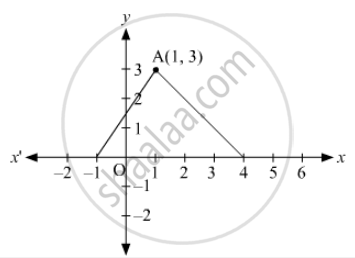Advertisements
Advertisements
प्रश्न
Show that the points (−2, 3), (8, 3) and (6, 7) are the vertices of a right triangle ?
उत्तर
The given points are A (−2, 3), B (8, 3) and C (6, 7).
By, distance formula, AB `sqrt{{8-(-2)}^2+(3-3)^2`
`rArr AB^2=10^2+0`
`rArrBC^2=100`
`BC=sqrt((6-8)^2+(7-3)^2)`
`rArrBC^2=(-2)^2+4^2`
`rArrBC^2=4+16`
`rArrBC^2=20`
`BC=sqrt((-2-6)^2+(3-7)^2)`
`rArrCA^2=(-8)^2+(-4)^2`
`rArrCA^2=64+16`
`rArrCA^2=80`
It is observed that BC2 + CA2 = 20 + 80 = 100 = AB2
So, by the converse of Pythagoras Theorem, ΔABC is right angled at C.
APPEARS IN
संबंधित प्रश्न
On which axis do the following points lie?
Q(0, -2)
Find the coordinates of the circumcentre of the triangle whose vertices are (3, 0), (-1, -6) and (4, -1). Also, find its circumradius.
Find the coordinates of the point where the diagonals of the parallelogram formed by joining the points (-2, -1), (1, 0), (4, 3) and(1, 2) meet
Prove that (4, 3), (6, 4) (5, 6) and (3, 5) are the angular points of a square.
Determine the ratio in which the point P (m, 6) divides the join of A(-4, 3) and B(2, 8). Also, find the value of m.
Show that the following points are the vertices of a square:
A (0,-2), B(3,1), C(0,4) and D(-3,1)
Show hat A(1,2), B(4,3),C(6,6) and D(3,5) are the vertices of a parallelogram. Show that ABCD is not rectangle.
Find the ratio which the line segment joining the pints A(3, -3) and B(-2,7) is divided by x -axis Also, find the point of division.
If the point C(k,4) divides the join of A(2,6) and B(5,1) in the ratio 2:3 then find the value of k.
The perpendicular distance of the point P (4, 3) from x-axis is
The distance of the point P (4, 3) from the origin is
Show that the points (−4, −1), (−2, −4) (4, 0) and (2, 3) are the vertices points of a rectangle.
Find the centroid of the triangle whose vertices is (−2, 3) (2, −1) (4, 0) .
Write the coordinates the reflections of points (3, 5) in X and Y -axes.
If Points (1, 2) (−5, 6) and (a, −2) are collinear, then a =
The length of a line segment joining A (2, −3) and B is 10 units. If the abscissa of B is 10 units, then its ordinates can be
In Fig. 14.46, the area of ΔABC (in square units) is

If the sum of X-coordinates of the vertices of a triangle is 12 and the sum of Y-coordinates is 9, then the coordinates of centroid are ______
If the coordinates of the two points are P(–2, 3) and Q(–3, 5), then (abscissa of P) – (abscissa of Q) is ______.
The distance of the point (–6, 8) from x-axis is ______.
